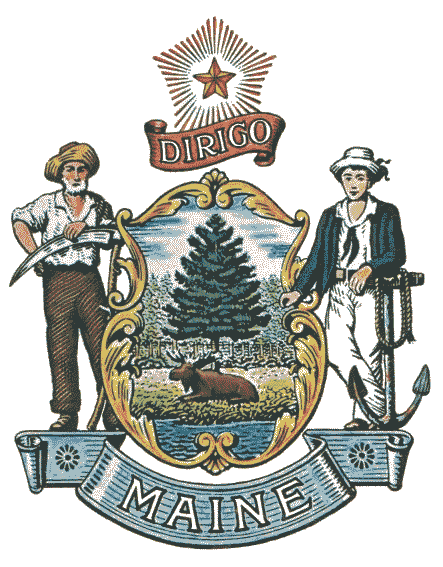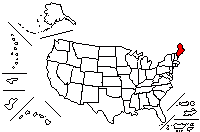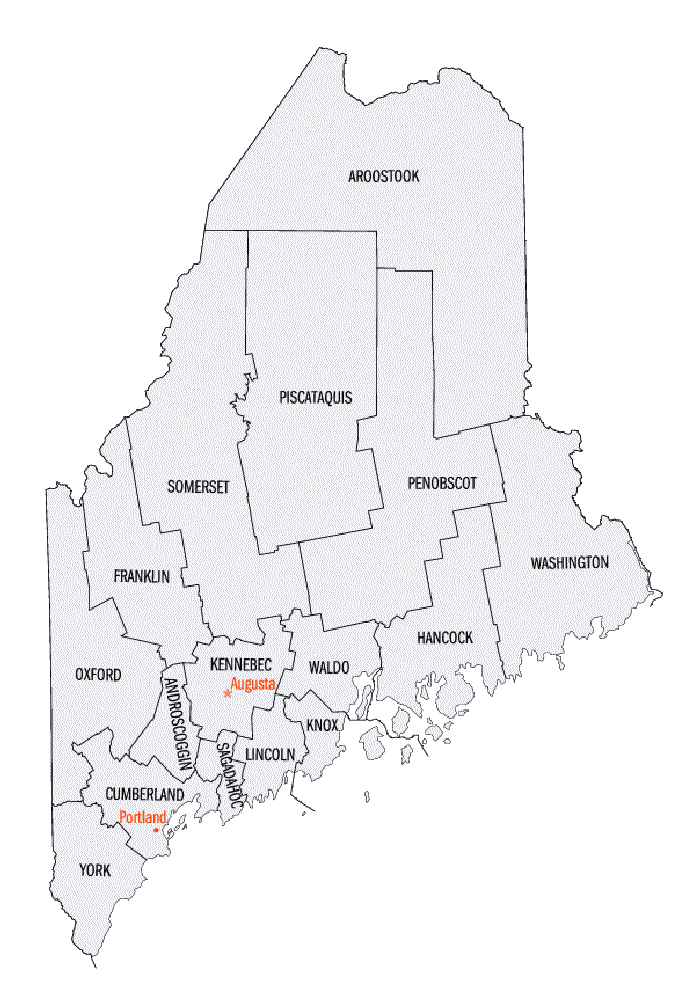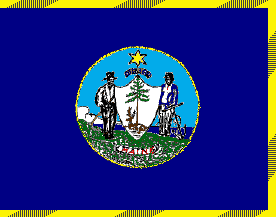
 |
|

















State of Maine Song |
La Canción de Maine |


Flag:
The state coat of arms is placed on a blue field. In the center of the shield a
moose rests under a tall pine tree. A farmer and seaman represents the work that
people did in early times. The North Star represents the state motto:
"Dirigo". ("I Direct" ) Flag adopted 1909.
Bandera:
Es escudo de armas del estado se colocado en un campo azul.
En el centro
del escudo un alce se reclina debajo de un árbol alto del pino.
Un granjero y un marinero representa el trabajo que la gente hizo en
épocas tempranas. La estrella del norte representa el lema del
estado: " Dirigo ". ("dirijo") la bandera se adoptó en el 1909.

Maine
Maine (se pronuncia Mé-in en inglés y español)
Capital City: Augusta
Admission to Statehood: March 15, 1820
National: mainers
Motto: Dirigo
I direct
In the design of the seal, the star above the motto is intended to
symbolize the state. The motto continues a navigational metaphor to the effect
that the state should be a guiding light to its citizens just as the citizens
should direct their efforts to the well-being of the state.
Nickname: Pine Tree State
Origin of state's name: Named by France. Assumed to be a reference to
the state region being a mainland,
different from its many surrounding islands.
Ciudad Capital: Augusta (se pronuncia Au-gus-ta en inglés y español)
Admición como estado: 15 de marzo de 1820
Gentilicio: mainense
Lema: Dirigo - Yo dirijo
En el diseño del sello, la estrella sobre el lema simboliza al
estado. El lema continua metáfora para que tenga el efecto de que el estado como una luz
guia para los ciudadanos, solo como ciudadanos dirigiran sus esfuerzos a que el estado
le valla bien.
Cognómento: Estado del Arbol de Pino
Origen del nombre: Nombre dado por los franceses. Se asume que es como referencia a la región del
estado siendo un "mainland" (se pronuncia Mein land) (significa tierra principal)
y así diferenciarlo de todas sus islas que la rodean.


The Seal:
In June of 1820, three months after Maine became a state,
the legislature drafted the design of the state seal. Since that
time, there have been variations in the details of the seal, but
the overall design and images remain true to the spirit of that
legislative session. The center of the seal is a shield adorned
with a tranquil scene of a moose resting in a field bordered by
water and woods, with a pine tree standing tall directly behind
the moose. On either side of the shield, a farmer rests on his
scythe, and a sailor leans on an anchor. Above the shield is the
motto "Dirigo" ("I lead"), and a stylized North Star. And below
the shield is a banner that simply reads "Maine". The legislature
of 1919 decided that the design of the seal should no longer vary,
and froze the design, and it is still used today.
El Sello
En junio de 1820, tres meses después de que Maine se convirtió en un
estado, la legislatura bosquejó el diseño del sello del estado.
Desde ese tiempo, ha habido variaciones en los detalles del sello,
pero el diseño total y las imágenes siguen siendo igual al
espiritu de esa sesión legislativa. El centro del sello es un
escudo adornado con una tranquila escena de un alce que se
reclina en un campo rodeados por el agua y los bosques, con un árbol
del pino estando a lo alto directamente detrás del alce.
A cada lado del escudo, un granjero se reclina sobre su
guadaña, y un marinero se recuesta en un ancla. Sobre el escudo
está el lema " Dirigo " ("Dirijo"), y una estilizada estrella del norte. Y debajo del escudo está una cinta que lee
simplemente " Maine ". La legislatura de 1919 decidió que el diseño
del sello no debía variar más, y debuto el diseño, y
todavía se utiliza hoy.

Located in the extreme northeastern section of the United States,
Maine is bordered by the Canadian provinces of Quebec on the
northwest and New Brunswick on the north and east, by New Hampshire
on the west, and by the Atlantic Ocean on the southeast and south.
History
Although Maine is a relatively small state, it constitutes almost half of New England.
The state's name is believed to be a contraction of the word mainland.
Early explorers of the region described it as "The Main" to distinguish
it from the offshore islands. Maine became the official name of the state
when it joined the union in 1820. Residents of New England sometimes call
Maine "Down East" because ships sailing north from Boston to Maine were
sailing downwind.
Norse explorers may have reached Maine in about AD 1000, but
the first European settlement was a short-lived one, established
by the sieur de Monts and Samuel de Champlain in 1604.
King James I of England included the region in his grant to the Plymouth Company,
and another unsuccessful attempt was made to settle the region in 1607-08.
The French established a settlement on Mount Desert Island in 1613 but were
soon expelled by the English. Permanent English settlement began after 1622,
when the Council for New England granted the territory between the Kennebec
and Merrimack rivers to Sir Ferdinando Gorges and John Mason. In a division
of the area in 1629, Gorges took the portion east of the Piscataqua River,
which was chartered in 1639 as the "Province and Countie of Maine." In 1652
the Massachusetts Bay Colony assumed jurisdiction over Maine, although the
Gorges heirs disputed Massachusetts' claim until 1677.
English settlement in Maine was hindered by repeated conflicts with the
Indians and the French (see King Philip's War; French and Indian Wars).
Nonetheless, the granting of a new charter to Massachusetts in 1691, which
reaffirmed its control of Maine, led to the establishment of local
government and institutions modeled on those of Massachusetts. In the
18th century the foundations for Maine's prosperous fishing, lumbering,
and shipbuilding industries were laid.
The Revolution
In 1765, Maine joined Massachusetts in resisting the Stamp Act (The Stamp Act
sponsored by George Grenville, was the first direct tax imposed by Britain on
its American colonies.)
The Sons of
Liberty (The Sons of Liberty was a secret American intercolonial organization
founded in November 1765 to oppose the Stamp Act).
in Maine held their own "tea party" in York. Maine men were among
the first to fight in the Revolutionary War; many coastal communities were
attacked by the British, and the coastal town of Falmouth was destroyed.
Although all areas east of the Penobscot River were occupied by the British,
strong resistance was made by the colonists near Machiasport where the first
naval battle of the Revolution took place on June 12, 1775, resulting in the
capture of the British ship Margaretta. In 1775, Benedict Arnold led his
unsuccessful expedition against Quebec through Maine. Other attempts to
dislodge the British from eastern Maine were also unsuccessful, and so
Britain retained control of the area throughout the war.
Statehood
After the United States won its independence, Maine grew in importance.
More and more citizens of the state began to agitate for statehood, but
it was not won until 1820, after eastern Maine had once again been occupied
by the British during the War of 1812 . According to the Missouri Compromise (The Missouri
Compromise of 1820-21 was an attempt to solve the sectional disputes between
free and slave states in the United States.)
of 1820, Maine was admitted to the union as a free state balanced by Missouri
as a slave state. Maine's capital was at Portland but was moved (1832) to Augusta.
The new state grew rapidly in population and prosperity, largely through timber
trade with Asia, Europe, and the West Indies, and as a center of shipbuilding,
notably at Bath. Maine made important contributions of men and supplies
to the Union during the Civil War. Over 73,000 Maine men served in the Union
army, and about 7,000 lost their lives.
Following the Civil War, Maine's population growth slowed significantly
despite considerable immigration of English-speaking Canadians, French
Canadians, Irish, and other Canadians, as well as attempts to attract European
immigrants. Many coastal towns lost population while there was continued growth
in the interior. Meanwhile, increased state and local government services such
as improvement and expansion of roads, streets, lighting, fire protection,
public education, and public libraries took place. Private enterprises expanded
electricity networks, communication systems, public transportation,
and manufacturing enterprises. The economy of Maine gradually shifted from
agriculture, fishing, and lumbering, which peaked between 1865 and 1880,
to manufacturing, which became the leading sector by 1900.
Localizado en la sección del noreste extrema de los Estados Unidos,
Maine es rodeado por las provincias canadienses de Quebec en el
noroeste y el New Brunswick en el norte y al este, por New Hampshire
en el oeste, y por el Océano Atlántico en el sureste y al sur.
Aunque Maine es un estado relativamente pequeño, casi constituye la
mitad de Nueva Inglaterra. El nombre del estado se cree para ser una
contracción de la palabra "mainland". Los exploradores
de la región la describieron como "The Main" para distinguirla
de las islas costa afuera. Maine se convirtió en el nombre oficial
del estado cuando entró la unión en 1820. Los residentes de
Nueva Inglaterra llaman a veces Maine "bajo este " porque las
naves que navegaban al norte de Boston a Maine navegaban viento abajo.
Los exploradores nórdicos pueden haber alcanzado Maine en
alrededor el año 1000, pero el primer establecimiento europeo fué
de breve duración, establecido por el sieur de Monts y Samuel de
Champlain en 1604. El Rey James I de Inglaterra incluyó la región en
su concesión a la Plymouth Company, y otra tentativa fracasada fue
hecha al tratar de habitar la región en 1607-08. Los franceses establecieron
un poblado en Mount Desert Island en 1613 pero
pronto fueron expelidos por los ingleses. El establecimiento inglés
permanente comenzó después de 1622, cuando el consejo para Nueva
Inglaterra concedió el territorio entre los ríos kennebec y de
Merrimack a sir Ferdinando Gorges y John Mason. En una
división del área en 1629, Gorges tomó la porción al este del río
de Piscataqua, que fué dividido en 1639 como " Providence y el
Countie Maine." En 1652 la colonia de la bahía de Massachusetts
asumió la jurisdicción sobre Maine, aunque los herederos de Gorges
disputaron la demanda de Massachusetts hasta 1677. El establecimiento
inglés en Maine fue obstaculizado por conflictos repetidos con los
indios y los francés. No obstante, el conceder de una nueva carta a
Massachusetts en 1691, que reafirmaron su control de Maine, condujo al
establecimiento del gobierno local y de las instituciones tomaron como modelo a
los de Massachusetts. En el décimo octavo siglo las fundaciones para
la pesca de Maine, la explotación de árboles, y las industrias
prósperas de la construcción naval fueron impuestas.
La revolución
En 1765, Maine se unió a Massachusetts en resistir el
Stamp Act (El Stamp Act, patrocinado por
George Grenville, era el primer impuesto directo impuesto por Gran
Bretaña ante sus colonias americanas.)
. Los hijos de la libertad en Maine sostuvieron
sus el propios " Tea Party " en York. Los hombres de Maine
estaban entre los primeros en luchar en la guerra revolucionaria; los
Británicos atacaron a muchas comunidades costeras, y la ciudad
costera de Falmouth fue destruida. Aunque todas las áreas al este
del río de Penobscot fueron ocupadas por el británico, la
resistencia fuerte fue hecha por los colonos cerca de Machiasport
donde la primera batalla naval de la revolución ocurrió de junio el
12 de 1775, dando por resultado la captura de la nave británica
Margaretta. En 1775, Benedict Arnold condujo a su expedición
fracasada contra Quebec a través de Maine. Otras tentativas de
desalojar a los Británicos de Maine del este también
fracasaron, y así que Gran Bretaña conservó el control del área a
través de la guerra.
Estadidad
Después de que los Estados Unidos ganaran su independencia,
Maine creció en importancia. Más y más ciudadanos del estado
comenzaron a pedir la estadidad, pero no fue ganado hasta 1820,
después de que Maine del este hubiera sido ocupado de nuevo por los
Británicos durante la guerra de 1812. Según el compromiso de
Missouri de 1820 (El compromiso de Missouri de 1820-21 era una tentativa de solucionar
los conflictos seccionales entre los estados abolicionistas y esclavistas en
los Estados Unidos).
, Maine fue admitido a la unión como estado abolicionista
balanceado por Missouri como estado esclavista. La capital de Maine
estaba en Portland pero fue movido (1832) a Augusta. El nuevo estado
creció rápidamente en la población y la prosperidad, en gran parte
con comercio de la madera con Asia, Europa, e Indias del oeste, y como
centro de la construcción naval. Maine
hizo contribuciones importantes de hombres y de fuentes a la unión
durante la guerra civil sobre 73.000 hombres de Maine sirvieron en el
ejército de la unión, y cerca de 7.000 perdieron sus vidas.
Después de la guerra civil, el crecimiento de la población de Maine
se retardó perceptiblemente a pesar de la inmigración considerable
de los canadienses de habla inglesa, canadienses franceses,
irlandeses, y otros canadienses, así como tentativas de atraer a
inmigrantes europeos. Muchas ciudades costeras perdieron a la
población mientras que había crecimiento continuado en el interior.
Mientras tanto, los servicios del estado creciente y de gobierno
local tales como mejora y extensión de caminos, de calles, de la
iluminación, de la protección contra los incendios, de la educación
pública, y de bibliotecas públicas ocurrieron. Las empresas
privadas ampliaron redes de la electricidad, sistemas de
comunicación, el transporte público, y las empresas de la
fabricación. La economía de Maine cambió de puesto gradualmente de
la agricultura, de la pesca, y de la explotación de árboles, que
enarbolaron entre 1865 y 1880, a la fabricación, que se convirtió en
el sector principal antes de 1900.
